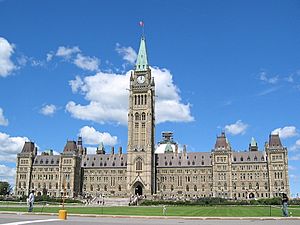Gradual Enfranchisement Act facts for kids
Quick facts for kids Gradual Enfranchisement Act |
|
|---|---|
 |
|
| An Act for the gradual enfranchisement of Indians, the better management of Indian affairs, and to extend the provisions of the Act 31st Victoria, Chapter 42 | |
| Enacted by | Parliament of Canada |
| Date assented to | June 22, 1869 |
The Gradual Enfranchisement Act was a law passed in 1869 by the Parliament of Canada. Its full name was An Act for the gradual enfranchisement of Indians, the better management of Indian affairs, and to extend the provisions of the Act 31st Victoria, Chapter 42. This act brought in new rules for how the Canadian government managed Indigenous peoples in Canada.
A key part of the act was setting up elected band councils. This meant that Indigenous communities would have leaders chosen by their members. The Gradual Enfranchisement Act updated an earlier law from 1857 called the Gradual Civilization Act. Later, this 1869 act was replaced by the Indian Act in 1876.
Contents
Understanding the Gradual Enfranchisement Act
This law introduced several important changes for Indigenous peoples in Canada. It aimed to control land ownership and how Indigenous communities were governed. The act also changed what it meant to be recognized as an "Indian" by the government.
Land Ownership and Citizenship
Under this act, only certain people could own land on reserves. These were people chosen by the Superintendent-General of Indian Affairs. If an Indigenous person chose to become "enfranchised," they would become a full Canadian citizen.
To become enfranchised, Indigenous people had to adopt English names. Once enfranchised, they could receive land grants outside of reserves. However, becoming enfranchised also meant giving up their Indigenous status and rights.
How Band Councils Were Formed
Section 10 of the Act allowed the Governor to order that Chiefs of any Indigenous group be elected. Only male members of the community, aged 21 or older, could vote. The act also said there would be "sub-Chiefs" for every 200 people in a group.
Duties of Band Chiefs and Councils
Section 11 of the Act listed what Chiefs were responsible for. They had to make sure roads, bridges, ditches, and fences on their reserve were kept in good condition. If the Superintendent General of Indian Affairs thought these were not in order, they could order repairs. The cost of these repairs would be taken from the reserve's annual money allowance.
Section 12 of the Act also outlined other duties for Chiefs and Councils:
- Taking care of public health in the community.
- Keeping order during community meetings and other events.
- Working to prevent drunkenness and wasteful behavior.
- Stopping cattle from trespassing on land.
- Maintaining roads, bridges, ditches, and fences.
- Building and repairing schoolhouses, council houses, and other public buildings.
- Setting up animal pounds and appointing people to manage them.
The Royal Commission on Aboriginal Peoples later noted that elected band councils were a key part of this act. They said that while the earlier Gradual Civilization Act only affected land ownership, the Gradual Enfranchisement Act started to interfere with how Indigenous communities governed themselves.
Defining "Status Indian" Under the Act
The Act also changed how someone was defined as a "status Indian." People who had "less than one-fourth Indian blood" could no longer share in the money paid to their band. This rule applied to those born after the act was passed.
The act decided a person's Indigenous status based on the men in their family. This was different from how many Indigenous communities decided kinship. If a married Indigenous man became enfranchised, he would lose his Indian status. His wife and children would also lose their status.
Impact on Indigenous Women
Section 6 of the Act had a significant impact on Indigenous women. It stated that any Indigenous woman who married a non-Indigenous person would lose her Indian status. This also meant her children from that marriage would not be considered Indigenous under the act.
Additionally, if an Indigenous woman married an Indigenous man from a different First Nation, she would lose her membership in her original First Nation. This rule often forced women to leave their home communities.
See also
- Gradual Civilization Act
- Detraditionalization
- Detribalization
- Tribal disenrollment
- Indian termination policy
- Cultural assimilation of Native Americans

